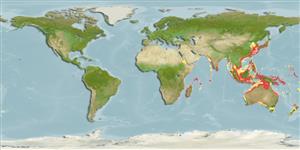Common names from other countries
Environment: milieu / climate zone / depth range / distribution range
Ecologie
; diepteverspreiding 0 - 100 m (Ref. 348). Tropical
Indo-West Pacific: from East Africa, to Melanesia; north to East China Sea and Japan, and south to Queensland and New Caledonia.
Length at first maturity / Size / Gewicht / Leeftijd
Maturity: Lm ? range ? - ? cm Max length : 5.0 cm SHL mannelijk/geslacht niet bekend; (Ref. 348); common length : 4.0 cm SHL mannelijk/geslacht niet bekend; (Ref. 348)
It is commonly collected for food in eastern Africa (Ref. 348).
Life cycle and mating behavior
Geslachtsrijpheid | Voortplanting | Kuitschieten | Eieren | Fecundity | Larven
Members of the class Bivalvia are mostly gonochoric, some are protandric hermaphrodites. Life cycle: Embryos develop into free-swimming trocophore larvae, succeeded by the bivalve veliger, resembling a miniature clam.
Poutiers, J.M. 1998. (Ref. 348)
Status op de Rode Lijst van het IUCN (Ref. 130435: Version 2024-1)
Status bij CITES (Ref. 108899)
Not Evaluated
Not Evaluated
Gevaarlijk voor mensen
Harmless
Gebruik door de mens
| FishSource |
Tools
Meer informatie
Leeftijd/Grootte
Groei
Lengte-gewicht parameters
Lengte-lengte parameters
Morfologie
Larven
Abundantie
Internet-bronnen
Estimates based on models
Preferred temperature
(Ref.
115969): 23.1 - 29.1, mean 28 (based on 1996 cells).
Kwetsbaarheid
Low vulnerability (10 of 100).
